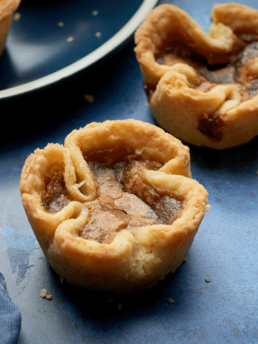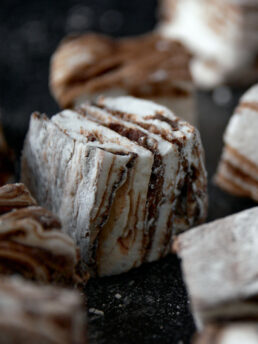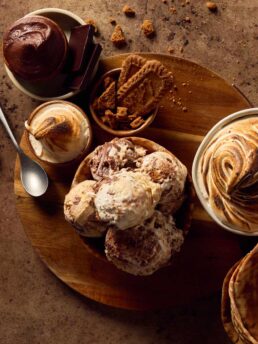Pistachio Paste: A Must-Have Recipe for Your Pastry Pantry
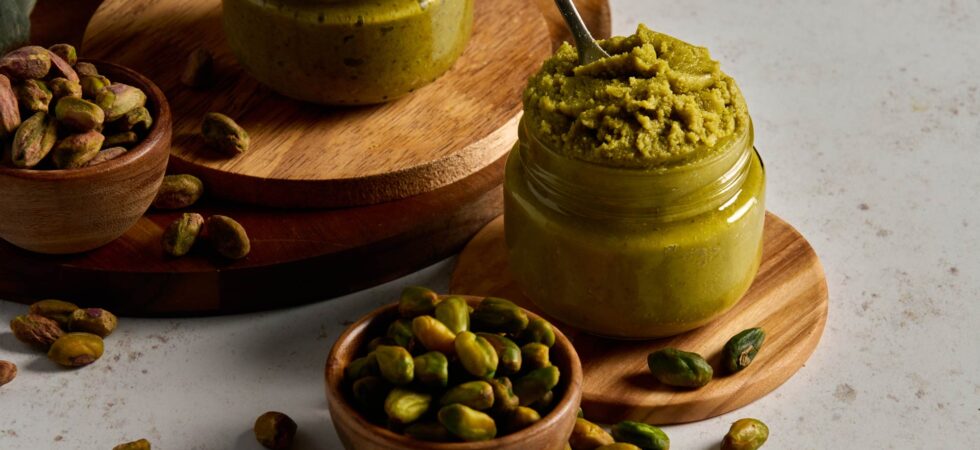
Pistachio Paste is essentially a roasted, candied, nut puree. And, I have to say, it feels like there are a million starting points and shortcuts to talk about. Textbook, perfect pistachio paste takes between 1.5-2 hours. With shortcuts, it can take as little as 20 minutes. Big time difference! But, there will also be a difference in flavor, color, and texture. Not enough for me to shy away from the 20 minutes version, but enough that if I want something special, I will definitely put in the extra work.
This recipe covers that can’t eat, can’t sleep, reach for the stars over the fence, world series kind of pistachio paste and includes all the variations and shortcuts (based on what you may be baking or have access to from your supermarket) in the notes and FAQ section. Ready? OKAY. LET’S GO!
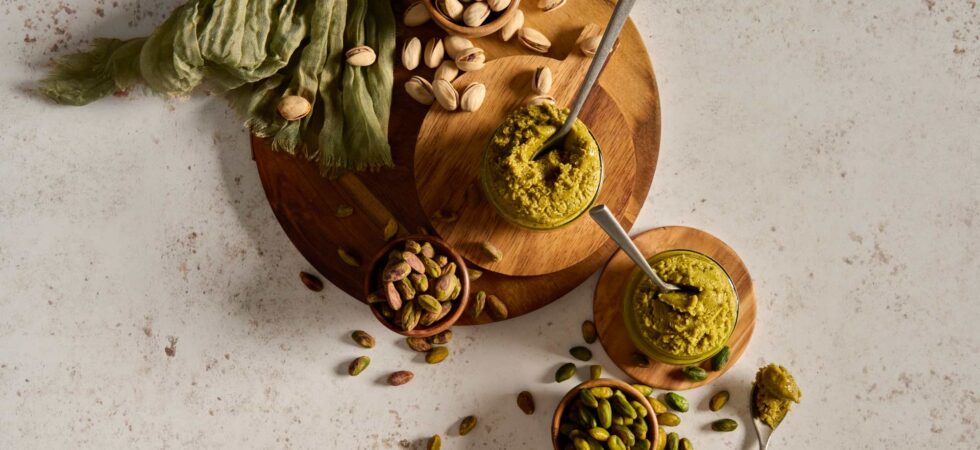
Get the Recipe: Pistachio Paste
Ingredients
- ¾ cup raw, unsalted pistachios
- 1 tablespoon + 1 teaspoon water
- ¼ cup sugar
- ⅓ cup almond flour
- ¼ teaspoon almond or pistachio extract, optional
- ½ teaspoon kosher salt
- 1-2 tablespoons neutral oil or almond liquor, optional
Equipment
- 1 kitchen scale
- 1 medium pot
- 1 medium bowl
- 1 spider or fine mesh strainer
- 1 kitchen towel
- 1 baking tray
- 1 Food thermometer
- 1 spatula
- 1 food processor or high powered blender
- 1 Immersion blender if needed, for a thinner paste
Instructions
Shell
- First, shell the pistachios by forcing the outside shell open and letting the raw pistachio nut fall out.
- Separate out the green nuts from the brown ones until you have the amount of green nuts needed for the recipe. Shells are not included in the weight/volume of nuts needed.
Blanch
- Next, get a medium sized pot with water and place it on your stovetop. Turn the heat on high and bring the water to a rolling boil. While that heats, fill a bowl with half ice and water and set it aside. When the water is boiling it’s time to blanch the shelled pistachios. Gently add the nuts to the boiling water using a spider or fine mesh strainer and let them cook until you see the skins start to lift away from the nuts. This should take between 1-3 minutes. If you cook the nuts too long, they will turn into mush so make sure to watch the pot and take them out as soon as possible.
- When the pistachios are ready to leave the water, scoop them out and immediately dunk them into the cold, ice water. Let them sit for 3-5 minutes in the ice water and then scoop them out and place them onto one half of an open kitchen towel.
Peel
- Fold the other half of the towel over the pistachios and roll it back and forth, to remove and/or begin separating the loosened skins from the nuts. Uncover the pistachios and finish removing the skins until they are all fully peeled.
Roast
- Next, preheat the oven to 300°F (150°C). Then, spread the pistachios out on a baking tray. Toast them in the oven for 15 minutes, moving them around at least once. When done, pour them onto a separate plate or tray to cool. Make sure they are still in a single layer and not in a pile or they will not cool fast enough.
Candy
- After about 10 minutes of cooling, the pistachios will be ready to candy. Measure and pour the sugar and water into a small sauce pot and turn the stove to medium-high heat. Once the sugar has dissolved and temperature of the syrup reaches 245°F (121°C), turn off the heat and add in the blanched and peeled pistachios. Stir everything around with a spatula. The syrup will turn hard and sandy as it coats the nuts and cools.
- Once the pistachios are coated and the sugar has fully crystallized, pour the pistachios back onto the baking sheet or plate and spread them out to cool once more.
Grind
- When cooled again add the candied pistachios, salt, almond flour, and almond (or pistachio) extract to a blender or food processor. Turn on it on for about 2 minutes and let it grind the nut mixture down to a coarse meal. When you see it start to clump, add in the oil a ½ tbsp (7.5ml) at a time. The meal will slowly become a thick paste. Depending on how thinned you want the pistachio paste, you can add more neutral oil or even some amaretto, a little (½ tbsp – 7.5ml) at a time. Add any additional salt to taste.
- Store at room temperature for 2 weeks or in the refrigerator for up to a month, if it makes it that long.
Notes
- This recipe can be scaled up or down as long as the ingredient ratios stay the same. 🙂
- Neutral oils to consider using include: safflower, grapeseed, and sunflower oils.
- If you use raw, salted pistachios, halve the salt in the recipe to be safe and then add salt to taste during grinding.
- If the paste is just not thinning out enough in your blender or food processor, you can also use an immersion blender.
- If you use roasted, salted pistachios, skip the roasting step and also halve the salt in the recipe. Add salt to taste during grinding. (see FAQ for expanded info)
- If you decide not to blanch and peel off the pistachio skins (only if you use pre-salted pistachios) completely leave out the salt in the recipe and then salt to taste later. (see FAQ for expanded info)
- If you use pre-salted and roasted pistachios (leave out the salt in the recipe) and decide not to blanch and peel them, this recipe can be made in about 30 minutes. That time includes sorting out green pistachios, candying, and grinding. If you don’t sort for the green nuts, it would be even less time. (see FAQ for expanded info)
- If you use almond extract, it does add a sweet nuttiness to the paste that I think enhances the pistachio flavor. However, if you decide to add it, do not add more than the recipe calls for. The almond extract can quickly over power the pistachio and all that work for pistachio paste will be lost. It will still taste good, but it won’t be what you were working towards.
Nutrition

Frequently Asked Questions
Pistachio paste, pistachio butter, and pistachio cream are used interchangeably in most of the food blog posts that I’ve seen. I understand why. But, I personally find this to be a mis-categorization that creates a lot of ambiguity.
– Pistachio paste is basically the baking equivalent of almond paste. You would never conflate almond paste and almond butter in pastry or baking applications. With a “paste” nuts and sugar are used to create a sweetened mixture, thicker than a nut butter. Pastes are typically used as a pastry filling.
– Pistachio butter, can be as simple as grinding nuts (no additions) until they are the consistency of honey; thick, but with a semi-liquid viscosity. It’s true, butters can also have the addition of roasting and sugar, think honey-roasted peanut butter. However, they are typically used as a mix in or drizzle.
– Pistachio cream, on the other hand, starts by grinding nuts. Then, sugar, milk or cream, and egg yolks (plus heat) are added to make a custard. It’s the pastry equivalent of crème pâtissière (crème pât), but with pistachio flavor. It’s used in the same applications as crème pât, e.g. filling for pastry and in between cake layers.
Hope this helps!
Purchasing pre-shelled pistachios is an easy call when you are trying to save some time and your fingers.
There is one caveat to this, however (there always is, isn’t there). Typically, pistachios with shells on are fresher than their pre-shelled counter parts. Meaning, there will be more green nuts than brown if you are willing to put in the effort of shelling the pistachios yourself.
It’s the quintessential balance between time versus money. Now that you are armed with that knowledge, I leave the decision to you on which option (pre-shelled or shell on) to choose.
TL;DR… you can skip this step.
Full answer… Roasting the pistachios above 300°F (150°C) does two things:
Causes the natural oils contained within the nuts to melt and become more fluid. These oils then migrate towards the surface of the nut, making it visibly glossy and helping ease the grinding process.
Triggers the Maillard reaction between the amino acids (proteins) and the reducing sugars (sucrose, glucose, fructose, and maltose) present in the nuts. This reactions intensifies the aroma and flavor of the nuts.
The length of roasting time and temperature can affect the degree of oil release and the final texture and flavor of the nuts. It’s essential to monitor the roasting process. It helps avoid overcooking and achieve the desired level of roasting. For this recipe, the roasting temperature and time are both low. This helps keep the pistachios’ signature green color as much as possible while still benefiting the final flavor and texture of the paste.
Want the keep the mild and fruity flavor present in raw pistachios? Skip the roasting process altogether. I actually prefer to use un-roasted pistachios when applying them to desserts that have lighter/more delicate flavors. I.e. mixing it into anything flavored with vanilla, like shortbread style cookies, milkshakes, or macarons.
Additionally, If you are looking for a deeply roasted flavor and the color doesn’t matter, feel free to increase the temperature as high as 350°F (177°C). Then roast for 10 minutes, stir, and repeat that process at 5 minute intervals, until you are happy with the results. I love a very roasted pistachio paste when eating it by itself, because obviously. Roasty, toasty paste is also delish alongside more robust flavorings, like chocolate or tart fruits.
Again, yes! I do this all the time. (oh look, another caveat!)
If you are using pre-salted pistachios, be aware that they are submerged in a brine before being roasted. This acts the same way that brining your holiday turkey or prime rib works. The salt, imbues the nuts all the way down into the nut meat. It is not simply a surface coating.
Because of this, I suggest cutting the salt in this recipe by half and then adding to taste from there. Different brands have different levels of sodium, so it’s best to be safe.
This is also completely okay. Keeping the skins on will not ruin pistachio paste. It will affect the texture and color of the paste most, but the flavor will be essentially the same.
Pistachio skins are brown/pink/purple. When those tones are mixed with the green of the nuts, the resulting paste more of an olive green or even ochre color. You will NOT end up with a bright vibrant green pistachio paste.
The skins are also harder to break up into a smooth paste than the nuts are. So, that silky smooth texture may be either harder to reach or unattainable depending on the size and power of your chosen grinding appliance.
Notes upon notes! Because I can…
In continuation of the previous FAQ, when you use pre-salted and roasted pistachios, the salt on the surface is removed during the blanching process. If you skip this step there will be even more salt present. If you don’t peel the nuts, I recommend completely leaving out the salt in the recipe. then salt to taste as you grind the final paste.
If you have access to it, a melanger (grinder used to pulverize cacao beans into chocolate or nuts into nut butters) will be the best choice to make pistachio paste. Just dump and go until you have the consistency you want.
Most people, including me, do not have access to a melanger. So, the choice is basically between a food processor and a blender. These are essentially interchangeable. However, a high-powered blender is going to be your best bet. Especially if the power of the appliances are equal.
Blender blades are better for grinding than a food processor’s blades, because a processor’s blades are level and do not touch the bottom of the container. They spin with a slicing motion, that needs friction and a certain level of food to pull everything around. A blender, with its bottom-situated, bent blades has a much better position for grinding. They too can be rendered useless, however, if there is not enough to blend or the blender is not powerful enough to handle thick foods. You may need to experiment to see which works better for you.
Honorable mention…if the blender or processor are only getting you so far and you happen to have an immersion blender, scrape the paste over to a cup or small bowl and use the blender to take it the rest of the way.
Pistachio paste can seize or become stiff and lumpy during processing due to the release of natural oils from the nuts too quickly. This extra release of oils happens if the pistachios used to make the paste aren’t cooled enough after they’ve been roasted or if they are over-processed during grinding. High temperatures and prolonged blending can cause the oils to separate more rapidly, leading to a grainy or thick texture in the pistachio paste.

